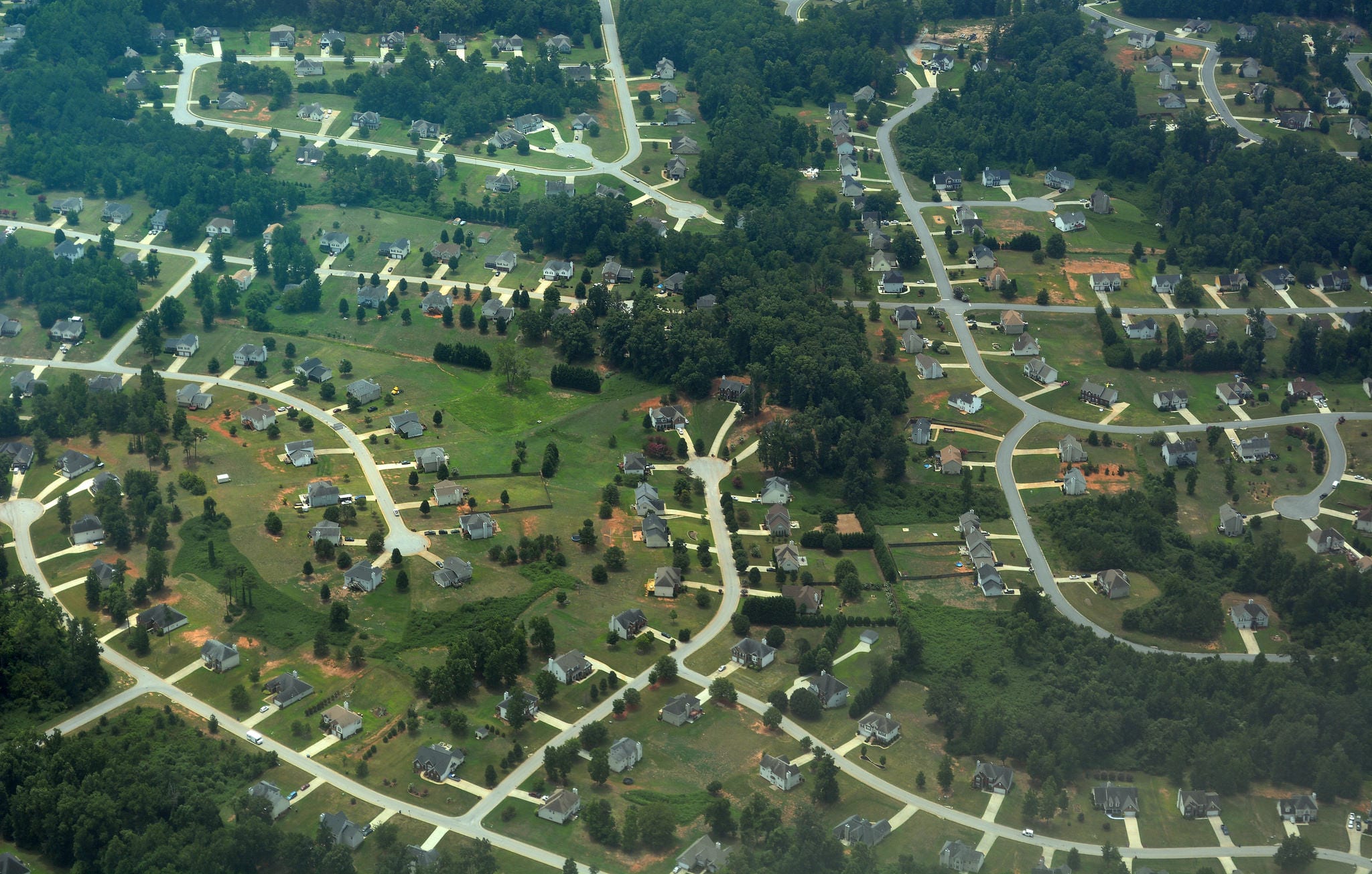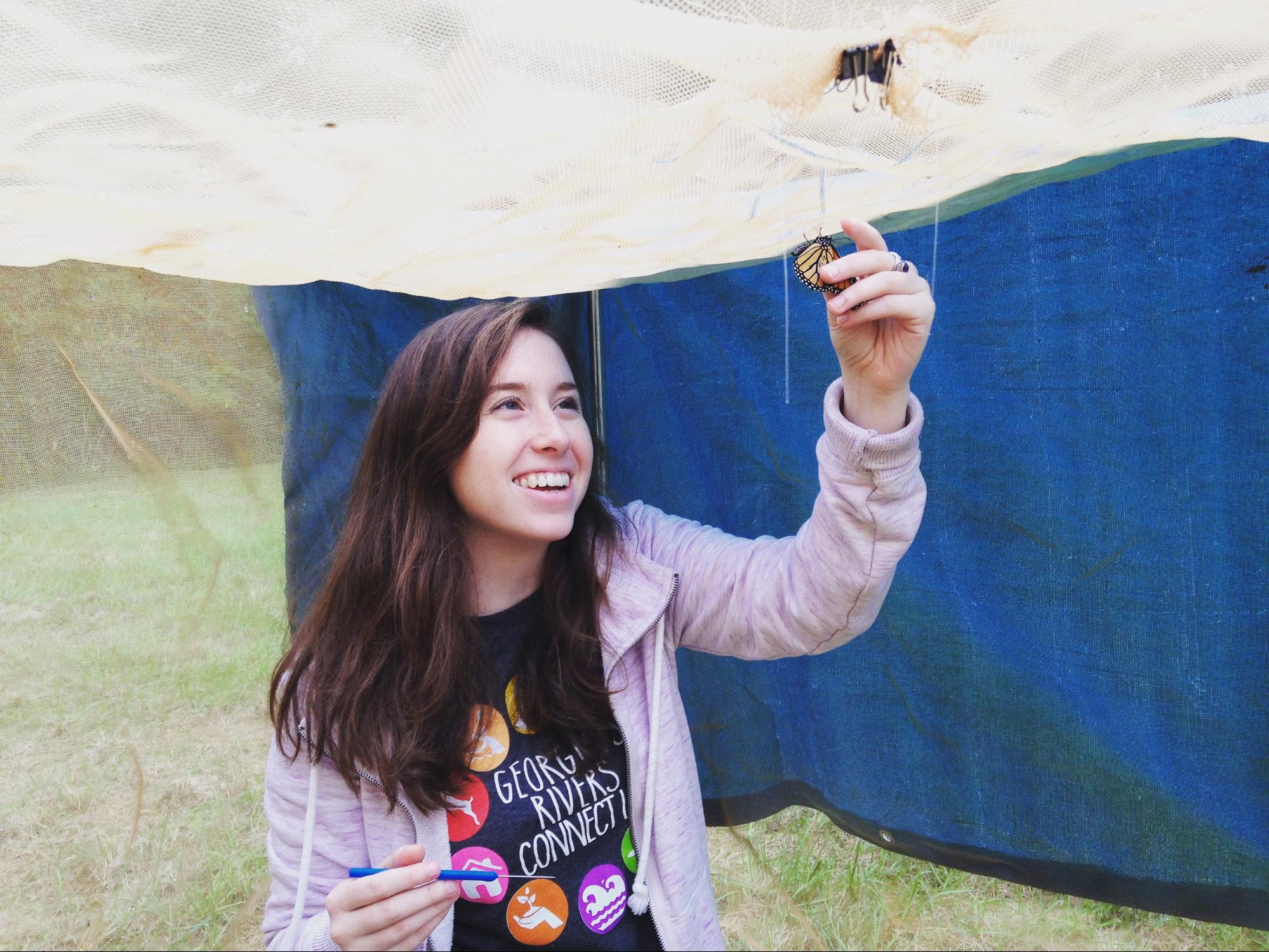
On every flight, there is a point when you sink below the clouds and a miniature version of the world unfurls before you. This is my favorite part about flying. Right before you land, the plane glides lower and lower and you get to see the world you experience every day from a different angle. The roads slither across the landscape, multiplying as they go. Crops form a patchwork quilt over the countryside, each field a distinct color from the next. But as we descend into Atlanta, what you mostly see are suburbs, suburbs, suburbs. They form a twisting, geometric serpent, squeezed together and capped with a cul-de-sac. Each house has a small yard clearly defined by a fence that screams “MINEâ€, and inside each of these carefully designated lawns is…nothing. No flowers. No trees. Just a monoculture of manicured grass.
It is perfectly cut, a single unwavering color without patches or bald spots. A yard is part of the suburban formula— it is the canvas on which we create the masterpiece that is a lawn. It represents a place for children and pets to play, a place to gather, a source of pride. All of these reasons are good and justified, but we can do so much better.
The Origin of Lawns
Creating a lawn is like taking one of Claude Monet's Water Lily paintings and painting over it with one thick layer of green paint. All of the intricate colors and textures are immediately eliminated. This has become our ideal–but why?
As you might expect, lawns are not an American invention. The earliest ancestor of modern lawns can be traced back to Europe as cleared forests around castles that prevented the landscape from concealing enemies. By the 17th century, lawns had become a symbol of status. Only the wealthiest landowners could afford the labor required to keep the grass trimmed and weeded. When the Europeans arrived in the US, they brought many things with them like horses, measles, and–you guessed it–lawns. Just like in Europe, the fluffiest, greenest sea of uninterrupted grass was prized as a sign of achievement. With the advent of affordable rotary lawn mowers, pesticides, fertilizers, and seed spreaders, the perfect lawn became attainable for the average American and soon huge swaths of the nation's natural artistry was painted over.
Horticulturally the US is not suited for growing lawns. In Europe, the rainy, mild climate means that grass grows easily and is not a stressor on the landscape. The climate in North America is less conducive, particularly in arid regions. However, we are determined to grow grass everywhere. If we consider lawns a crop, then grass is the single largest crop produced in the US, covering three times the area of irrigated corn by conservative estimates. This means our most abundant crop is essentially useless.
Thankfully, curing the U.S. of manicured lawns actually requires less work rather than more.
Rethinking Your Lawn: From cemetery to sanctuary
- Grass Clippings: One of the common lawn maintenance chores is to mow the grass, bag up the clippings and toss them to the curb for a garbage truck to whisk away. These piles of organic yard matter are estimated to account for 18% of the waste dumped in landfills. This means that a huge proportion of our waste disposal space is taken up by material that actually the perfect organic fertilizer! They are rich in nutrients like nitrogen and can help your lawn stay healthy. Instead of trashing them, you can add them to compost, mulch other parts of your yard or scatter them on your lawn and watch your yard grow even greener!
- Water: It is estimated that 9 billion gallons of water is used for landscape irrigation per day with up to 50% of this water being lost to wind, runoff, and evaporation. This puts unnecessary strain on reservoirs and aquifers that are struggling to match human demands. Much of this water waste comes from poor timing and application of water. We are all familiar with the ill-placed sprinkler head dumping half of its contents into the street. This irrigation problem can be essentially eliminated by establishing a diverse lawn of native plants. These plants are adapted to the soil composition and rainfall of your region and should require little to no supplementary water, allowing us to put those 9 billion gallons of water to more productive use.
If you are unable to convert your lawn to native cover species, here are a few tips for minimizing water loss in your lawn:
- Mow your grass at a height of at least three inches. The taller grass will shade the soil more and reduce water loss through evaporation.
- Water your lawn when the temperatures are lowest; either early in the morning or late in the evening.
- Use drip irrigation instead of a sprinkler to minimize water loss to evaporation and wind.
- Install a rain barrel under your gutter and water your lawn with the runoff.
- Pollinators: Looking at a lush green lawn, it may seem like a bounty of productivity and life. However, to insect pollinators, a strictly maintained lawn is a veritable desert—a sterile wasteland. With bumble bees and other native pollinators facing striking declines, lawns can represent critical habitat for these insects. Plants often considered “weeds,†like clover, dandelions and creeping thyme represent some of the largest food resources for hungry bees in urban environments. Not to mention they add beautiful colors to your lawn without the maintenance!
You can even go a step further and convert portions of your lawn into a pollinator garden with native nectar and host plants. This may sound like a lot of work, but planting native perennials that will return year after year means that one day of work will translate into years of color and valuable habitat. Click here to read more about why it is critically important that we plant milkweed across the US.
- Pollution: The US Fish and Wildlife Service has estimated that homeowners use up to 10 times more pesticides per acre in their yards than is found in conventional agriculture. These chemicals have the potential to runoff into local watersheds, to kill non-target insects like pollinators, and to degrade human health. Unless they are also used in food production, lawn pesticides are not tested for chronic health effects. This is particularly concerning for children whose brains, nervous systems, and organs are still developing and are thus more susceptible to chemical toxins. Children are more likely to come in close contact with the pesticides while playing outdoors and a child's liver and kidneys are less effective at removing the toxins from their system. A simple solution is to establish a variety of species in your lawn. A lawn that supports a diversity of plants is less likely to be destroyed by insects or disease, reducing the need for chemical pesticides. Welcoming weedy visitors into your yard also eliminates the need for herbicides.
Furthermore, the maintenance of lawns is a significant contributor to environmental contamination. It is estimated that a staggering 17 million gallons of gas are spilled while refilling yard equipment. In 2011 the EPA estimated that 26.7 million tons of pollutants were emitted by gas powered lawn equipment. These pollutants represent a significant contribution to the greenhouse gas emissions that are driving global climate change. The simple solution–stop mowing your lawn! If this isn't possible, switching to a push mower could prevent 80 lbs of CO2 from entering the atmosphere each year.
- Monoculture: As we discovered repeatedly in monoculture cropping systems (remember the Gros Michel banana and Panama disease), planting a vast expanse of a single plant drastically increases the plant's susceptibility to disease, pests, and nutrient limitation. To truly be healthy and beautiful, a lawn should function as an ecosystem that serves not just humans, but contributes to the ecology of the landscape. One way to accomplish this is to incorporate a variety of plant species in your yard. Diversity is a natural component of any ecosystem, ensuring that if one species is diseased or infected, some of the species around it will be immune and can replace it. A diversity of plants also can maintain the health of your lawn with different species demonstrating a gradient of drought tolerance, nutrient stress, and seasonality. A diverse lawn means that your yard will be green rain or shine, fall or spring, good times or bad.
Next time you find yourself flying over the Atlanta suburbs, don't be overwhelmed by the suburban monotony. But rather, let your imagination wander with excitement by the beautiful untapped potential of domestic greenspace! With each sustainable lawn, valuable habitat is added to the landscape. Maybe in a few years our birds-eye view will be different. All we have to do is let our lawns be free!
About the author:
 |
Hayley Schroeder is an undergraduate at UGA studying Ecology and Entomology. She is an enthusiastic foodie, advocating for food that nourishes not just the people eating it, but communities, farmers and the earth as well. She is also a friend to all insects and can be easily spotted on campus by her butterfly net. Contact her at hayleyadair37@uga.edu. More from Hayley Schroeder. |
About the Author
-
athenssciencecafehttps://athensscienceobserver.com/author/athenssciencecafe/April 17, 2020
-
athenssciencecafehttps://athensscienceobserver.com/author/athenssciencecafe/April 12, 2020
-
athenssciencecafehttps://athensscienceobserver.com/author/athenssciencecafe/April 3, 2020
-
athenssciencecafehttps://athensscienceobserver.com/author/athenssciencecafe/March 30, 2020







